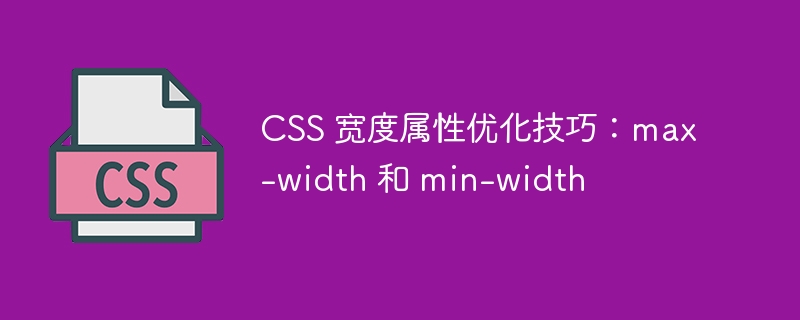

CSS width attribute optimization tips: max-width and min-width
In web design and development, setting the width of an element is a common task. In order to make web pages present well on screens of different sizes, we often use max-width and min-width attributes to control the width of elements. This article will introduce how to use these two attributes to optimize the design of web pages, and give some specific code examples.
The max-width attribute is used to set the maximum width of an element. When the screen size is larger than the set maximum width, the width of the element will be limited to this maximum value. This is useful in responsive design to ensure that elements don’t fit too loosely on large screens, keeping the page laid out properly.
The following is a simple example that demonstrates how to use max-width to control the maximum width of a div element to 500 pixels:
div { max-width: 500px; }
In the above example, if the screen size is less than 500 pixels, The width of the div element will automatically adjust to fit the screen size. But if the screen size is larger than 500 pixels, the width of the div element will stop growing and remain within 500 pixels.
The min-width attribute is used to set the minimum width of an element. When the screen size is smaller than the set minimum width, the element's width will be increased to accommodate this minimum value. This is also very useful in responsive design to ensure that elements are not too crowded on small screens, thus providing a better user experience.
The following is a simple example that demonstrates how to use min-width to control the minimum width of an image to 200 pixels:
img { min-width: 200px; }
In the above example, if the screen size is greater than 200 pixels, the image The width will remain within 200 pixels. But if the screen size is less than 200 pixels, the width of the image will automatically increase to fit the screen size.
The max-width and min-width properties can be used in combination to control the width of the element more flexibly. Here is an example that demonstrates how to set the minimum width of a div element to 300 pixels and the maximum width to 80%:
div { min-width: 300px; max-width: 80%; }
In the above example, if the screen size is less than 300 pixels, the width of the div element will be Automatically increases to 300 pixels. And if the screen size is greater than 80% of the current width, the width of the div element will stop growing and remain within 80% of the current width.
To sum up, the max-width and min-width attributes are very useful tools when developing responsive web pages, which can flexibly control the width of elements. By using these two attributes properly, we can ensure that the web page will look good on screens of different sizes.
The above is the detailed content of CSS width property optimization tips: max-width and min-width. For more information, please follow other related articles on the PHP Chinese website!
 What are the website building functions?
What are the website building functions? Which key should I press to recover when I can't type on my computer keyboard?
Which key should I press to recover when I can't type on my computer keyboard? number_format usage
number_format usage How to insert page numbers in ppt
How to insert page numbers in ppt What does context mean?
What does context mean? Douyin level price list 1-75
Douyin level price list 1-75 What are the differences between Eclipse version numbers?
What are the differences between Eclipse version numbers? Compatibility checker
Compatibility checker



